Sepura STP8280 Portable TETRA Radio User Manual TETRA Terminals
Sepura plc Portable TETRA Radio TETRA Terminals
Sepura >
Contents
MOD-10-1164_ Product Guide_5

sepura
TETRA Radios
Product Guide
MOD-10-1164
Issue 5
© SEPURA PLC 2011

MOD-10-1164
sepura
TETRA Terminals
Product Guide
October 28th 2011
Page 2 of 36
Issue 5
© Sepura plc 2011
Contents
CONVENTIONS _______________________________________________ 3
REGULATORY STATEMENTS ___________________________________ 4
Compliance with Standards _________________________________________________ 4
North American and Canadian markets ________________________________________ 5
OPERATIONAL REQUIREMENTS ________________________________ 8
Operating Conditions _______________________________________________________ 8
IP Ratings ________________________________________________________________ 8
HANDHELD RADIO RANGE _____________________________________ 9
STP8000, STP8100, STP8200 ________________________________________________ 10
SRH3500, SRH3800, SRH3900 _______________________________________________ 20
MOBILE / GATEWAY RADIO RANGE ____________________________ 25
SRG3000 Mobile / Gateway Transceiver ______________________________________ 26
Standard Console _________________________________________________________ 27
Colour Console ___________________________________________________________ 27
Handset Based Console ___________________________________________________ 28
Applications Interface Unit _________________________________________________ 29
Mobile / Gateway Radio Accessories _________________________________________ 29
Mobile / Gateway Radio Audio Control _______________________________________ 30
RADIO OPERATION __________________________________________ 31
HEALTH AND SAFETY ________________________________________ 32
User Information __________________________________________________________ 32
GLOSSARY _________________________________________________ 34
ACKNOWLEDGEMENTS ______________________________________ 35
NOTICE ____________________________________________________ 36
Contact Details ___________________________________________________________ 36
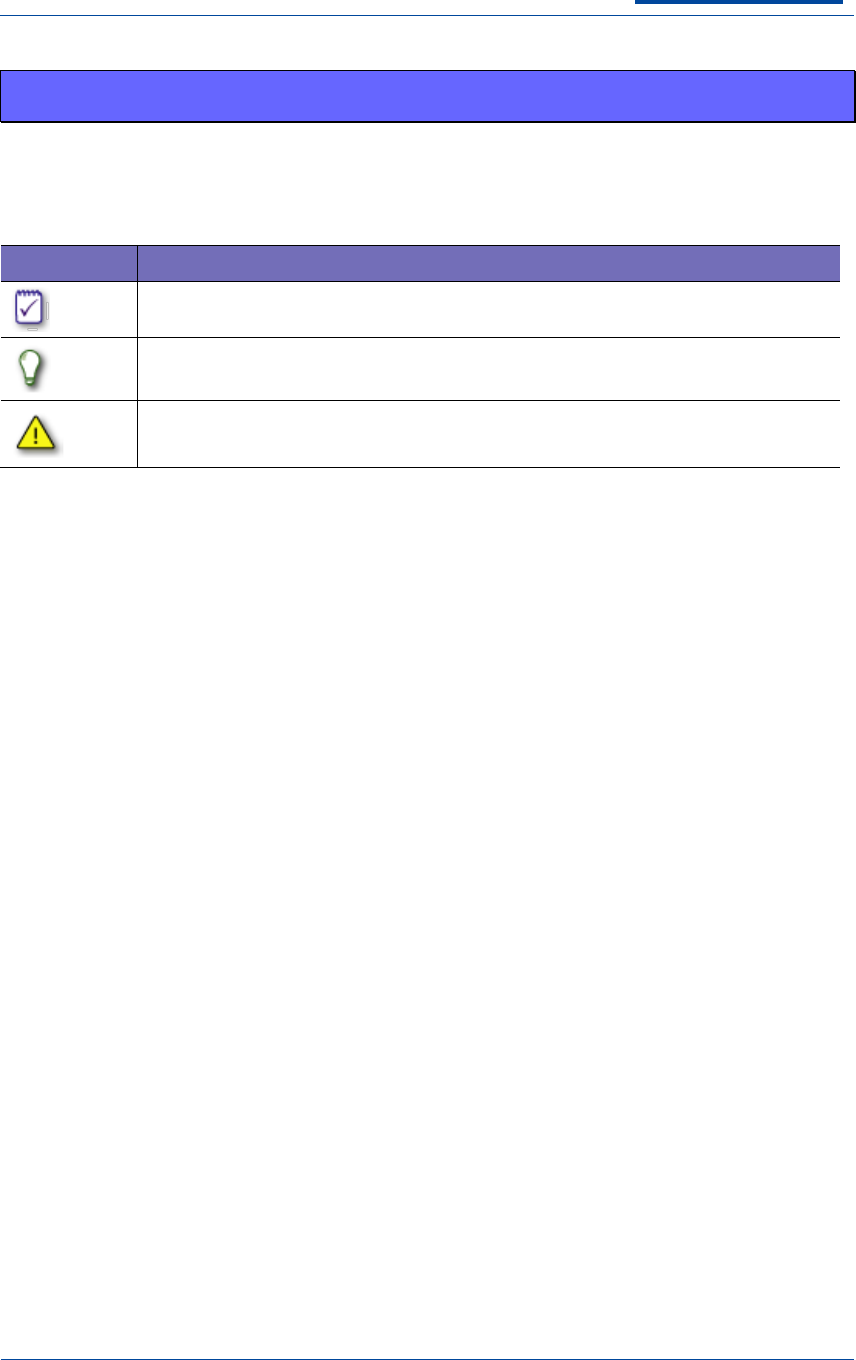
MOD-10-1164
sepura
TETRA Terminals
Product Guide
October 28th 2011
Page 3 of 36
Issue 5
© Sepura plc 2011
CONVENTIONS
This guide uses the following formatting and graphical conventions.
Convention
Description
Note icon. Emphasises related, reinforcing, or important information.
Tip icon. Suggests alternative methods for accomplishing tasks or
procedures.
Caution icon. Indicates actions or processes that require caution from the
user.

MOD-10-1164
sepura
TETRA Terminals
Product Guide
October 28th 2011
Page 4 of 36
Issue 5
© Sepura plc 2011
REGULATORY STATEMENTS
COMPLIANCE WITH STANDARDS
RADIATION PROTECTION
The radios fully comply with the NRPB specification EN50360 (EN50361) and the ICNIRP
guidelines for exposure to electromagnetic fields mandated for mobile phones (2W per kg
over a 10g sample).
ELECTRO MAGNETIC COMPATIBILITY
The radios meet the EMC requirements specified by the ETSI specifications:
ETSI EN 301 489-1,
ETSI EN 301 489-18
TYPE APPROVAL
The radios have been self-certified against the R&TTE Directive EN 303 035-1 and are CE
marked accordingly.
ENVIRONMENTAL
The radios fully comply with the following environmental regulatory requirements:
The MIL STD 810E standard for Salt Fog:
The MIL STD 810E standard for Driving Sand (SRH3000 radios only)
The radios have been self-certified to fully comply with all environmental aspects detailed by
ETSI EN 300 019. These include mechanical and climatic tests covering such things as drop,
vibration, bump and shock as well as temperature and humidity.
RADIO OPERATION
The radios meet the requirements specified by the ETSI specification EN 300 394-1.
SAFETY AND VEHICLE CERTIFICATION AGENCY (VCA)
The radios fully comply with the User Safety specification EN60950, and the Automotive
Directive detailed in 2006/28/EC.

MOD-10-1164
sepura
TETRA Terminals
Product Guide
October 28th 2011
Page 5 of 36
Issue 5
© Sepura plc 2011
NORTH AMERICAN AND CANADIAN MARKETS
The following regulatory statements apply to users in the North American and/or Canadian
markets.
SRG3900 RADIOS
Changes or modifications not expressly approved by the party responsible for compliance
could void the user‟s authority to operate the equipment (FCC rule part 15.21).
This device complies with part 15 of the FCC Rules. Operation is subject to the following two
conditions: (1) This device may not cause harmful interference, and (2) this device must
accept any interference received, including interference that may cause undesired operation.
(FCC Rule Part 15.19(a)(3)).
NOTE: This equipment has been tested and found to comply with the limits for a Class A
digital device, pursuant to part 15 of the FCC Rules. These limits are designed to provide
reasonable protection against harmful interference when the equipment is operated in a
commercial environment. This equipment generates, uses, and can radiate radio frequency
energy and, if not installed and used in accordance with the instruction manual, may cause
harmful interference to radio communications. Operation of this equipment in a residential
area is likely to cause harmful interference in which case the user will be required to correct
the interference at his own expense (FCC Rule Part 15.105).
When used with the High Gain Tetra Modular Whip antenna (maximum antenna gain 7dBi),
the antenna must be installed to provide a separation distance of at least 31 cm from all
persons during normal operation to ensure compliance for RF Exposure.
When used with the rigid Tetra Modular Whip antenna (maximum antenna gain 2dBi), the
antenna must be installed to provide a separation distance of at least 25 cm from all persons
during normal operation to ensure compliance for RF Exposure.
This Class A digital apparatus complies with Canadian ICES-003.
To reduce potential radio interference to other users, the antenna type and its gain should be
so chosen that the equivalent isotropically radiated power (e.i.r.p.) is not more than that
permitted for successful communication
This radio is intended for use in occupational/controlled applications where users have been
made aware of the potential for exposure and can exercise control over their exposure. This
radio device is NOT authorized for general population, consumer or similar use.
STP8040/STP8140 RADIOS
Changes or modifications not expressly approved by the party responsible for compliance
could void the user‟s authority to operate the equipment (FCC rule part 15.21).
This device complies with part 15 of the FCC Rules. Operation is subject to the following two
conditions: (1) This device may not cause harmful interference, and (2) this device must
accept any interference received, including interference that may cause undesired operation.
(FCC Rule Part 15.19(a)(3)).

MOD-10-1164
sepura
TETRA Terminals
Product Guide
October 28th 2011
Page 6 of 36
Issue 5
© Sepura plc 2011
NOTE: This equipment has been tested and found to comply with the limits for a Class A
digital device, pursuant to part 15 of the FCC Rules. These limits are designed to provide
reasonable protection against harmful interference when the equipment is operated in a
commercial environment. This equipment generates, uses, and can radiate radio frequency
energy and, if not installed and used in accordance with the instruction manual, may cause
harmful interference to radio communications. Operation of this equipment in a residential
area is likely to cause harmful interference in which case the user will be required to correct
the interference at his own expense (FCC Rule Part 15.105).
This Class A digital apparatus complies with Canadian ICES-003.
The use of third-party belt-clips, holsters, and similar accessories should not contain metallic
components in its assembly. The use of these accessories that do not satisfy these
requirements may not comply with appropriate RF exposure compliance requirements, and
should not be used.
To reduce potential radio interference to other users, the antenna type and its gain should be
so chosen that the equivalent isotropically radiated power (e.i.r.p.) is not more than that
permitted for successful communication
This radio is intended for use in occupational/controlled applications where users have been
made aware of the potential for exposure and can exercise control over their exposure. This
radio device is NOT authorized for general population, consumer or similar use.
STP8080/STP8280 RADIOS
Changes or modifications not expressly approved by the party responsible for compliance
could void the user‟s authority to operate the equipment (FCC rule part 15.21).
This device complies with part 15 of the FCC Rules. Operation is subject to the following two
conditions: (1) This device may not cause harmful interference, and (2) this device must
accept any interference received, including interference that may cause undesired operation.
(FCC Rule Part 15.19(a)(3)).
NOTE: This equipment has been tested and found to comply with the limits for a Class A
digital device, pursuant to part 15 of the FCC Rules. These limits are designed to provide
reasonable protection against harmful interference when the equipment is operated in a
commercial environment. This equipment generates, uses, and can radiate radio frequency
energy and, if not installed and used in accordance with the instruction manual, may cause
harmful interference to radio communications. Operation of this equipment in a residential
area is likely to cause harmful interference in which case the user will be required to correct
the interference at his own expense (FCC Rule Part 15.105).
The use of third-party belt-clips, holsters, and similar accessories should not contain metallic
components in its assembly. The use of these accessories that do not satisfy these
requirements may not comply with appropriate RF exposure compliance requirements, and
should not be used.

MOD-10-1164
sepura
TETRA Terminals
Product Guide
October 28th 2011
Page 7 of 36
Issue 5
© Sepura plc 2011
To reduce potential radio interference to other users, the antenna type and its gain should be
so chosen that the equivalent isotropically radiated power (e.i.r.p.) is not more than that
permitted for successful communication
This radio is intended for use in occupational/controlled applications where users have been
made aware of the potential for exposure and can exercise control over their exposure. This
radio device is NOT authorized for general population, consumer or similar use.

MOD-10-1164
sepura
TETRA Terminals
Product Guide
October 28th 2011
Page 8 of 36
Issue 5
© Sepura plc 2011
OPERATIONAL REQUIREMENTS
All features and functions of Sepura radios are subject to network support of the
TETRA Interoperability Specifications.
OPERATING CONDITIONS
All Sepura radios operate in a temperature range between -20ºC and 55ºC and a maximum
humidity of 98%.
IP RATINGS
The Sepura radios are certified to the following IEC529 IP standards:
Product
Standard
STP8000,
STP8100
IP55
STP8200
IP54
SRH3500,
SRH3800,
SRH3900
IP54
SRG3500,
SRG3900
IP54
The STP8000, STP8100 and STP8200 radios have been tested for a full 8 hour shift
in IP54 conditions. This is equivalent to 8 hours of constant rain.
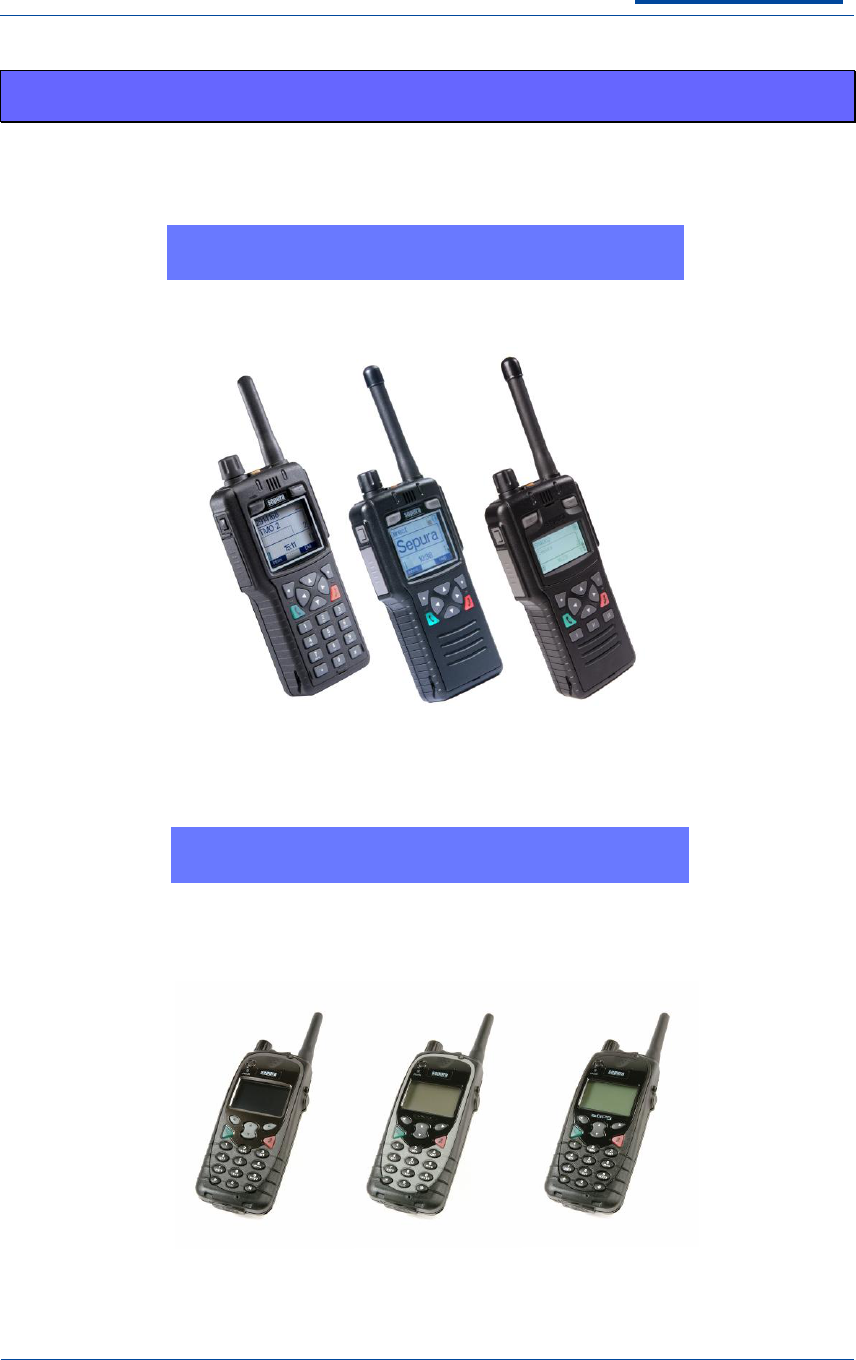
MOD-10-1164
sepura
TETRA Terminals
Product Guide
October 28th 2011
Page 9 of 36
Issue 5
© Sepura plc 2011
HANDHELD RADIO RANGE
STP8000 Series Radios
SRH3000 Series Radios

MOD-10-1164
sepura
TETRA Terminals
Product Guide
October 28th 2011
Page 10 of 36
Issue 5
© Sepura plc 2011
STP8000, STP8100, STP8200
STP8000 FRONT
Emergency Key
Navi-knob™
Mode Key
PTT
Navigation Keys
Select / Send Key
Duplex Earpiece and
Half-Duplex Microphone
-
Cancel / Home Key
Alphanumeric Keypad
(with Half-Duplex
speaker behind)
Facility Connector
Duplex Microphone
Blue LED
Antenna
Left Context Key
Right Context Key
Programmable
Soft Key
Tri-colour LED
Soft Key
(Default is Missed
Event Key)
Rugged Accessory
Connector
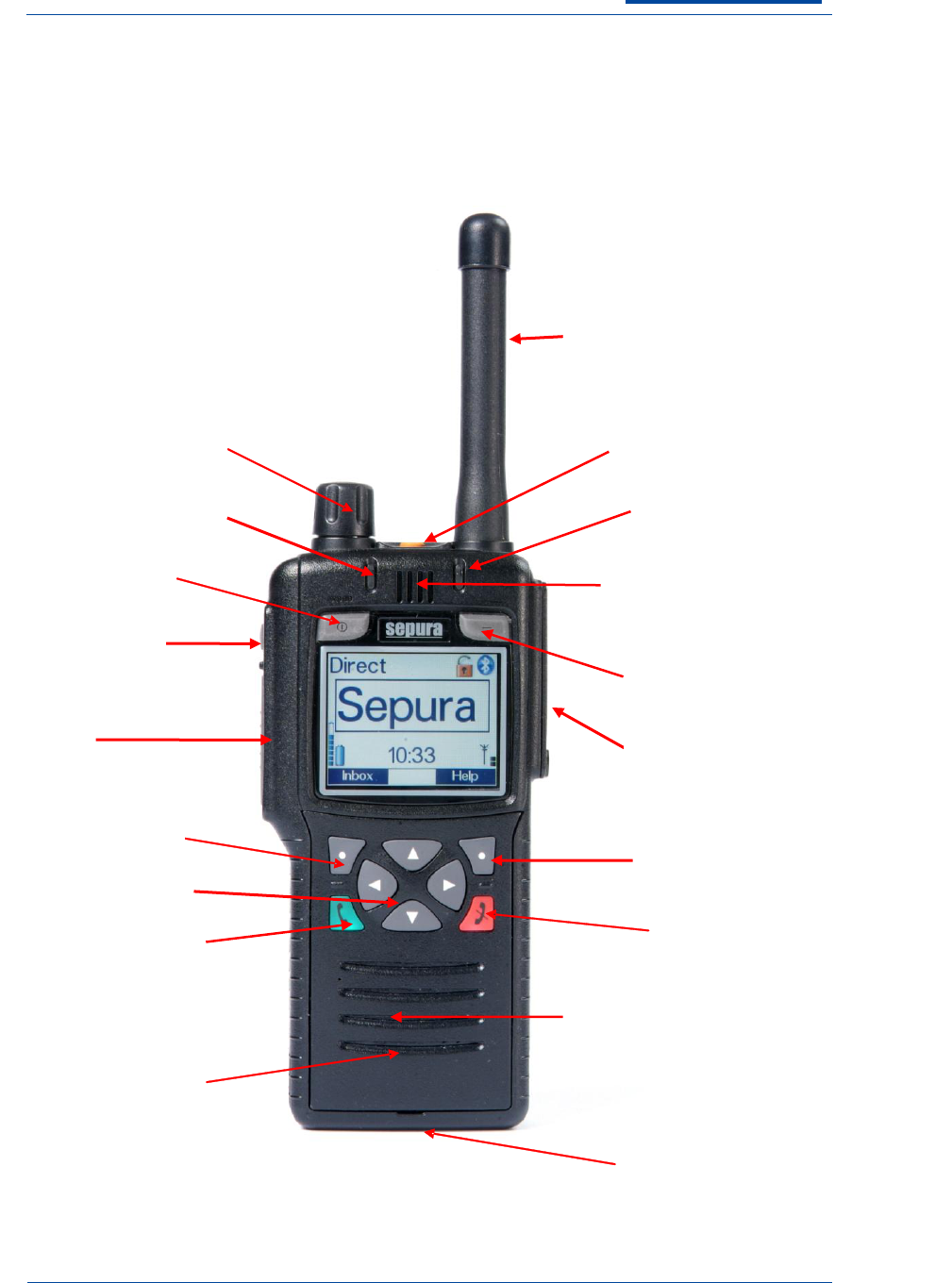
MOD-10-1164
sepura
TETRA Terminals
Product Guide
October 28th 2011
Page 11 of 36
Issue 5
© Sepura plc 2011
STP8100 FRONT
Emergency Key
Navi-knob™
Mode Key
PTT
Navigation Keys
Select / Send Key
Duplex Earpiece and
Half-Duplex Microphone
-
Cancel / Home Key
Half-Duplex speaker
Facility Connector
Duplex Microphone
-
Blue LED
Antenna
Left Context Key
Right Context Key
Programmable
Soft Key
Tri-colour LED
Soft Key
(Default is Missed
Event Key)
Rugged Accessory
Connector
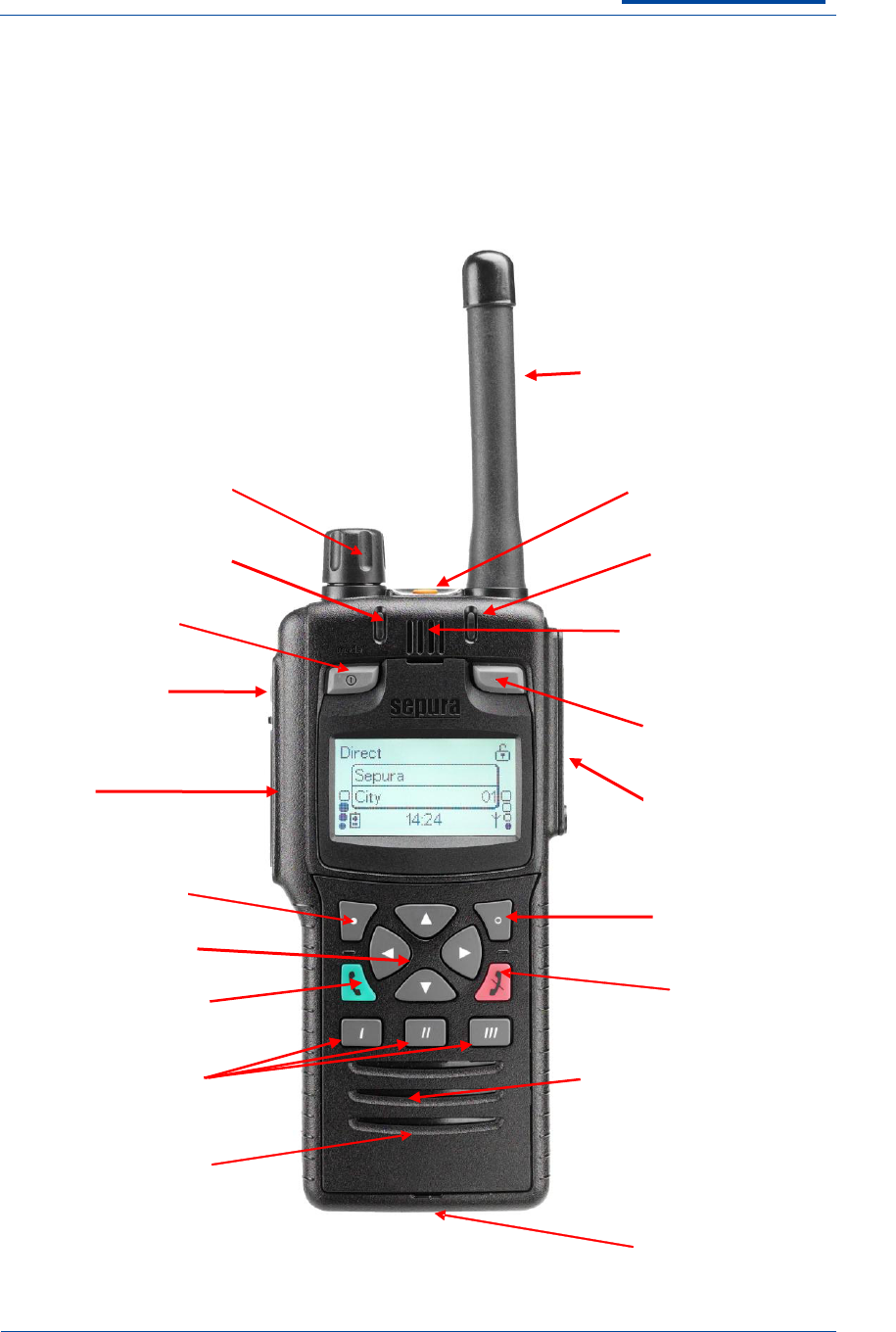
MOD-10-1164
sepura
TETRA Terminals
Product Guide
October 28th 2011
Page 12 of 36
Issue 5
© Sepura plc 2011
STP8200 FRONT
Soft Keys
Emergency Key
Navi-knob™
Mode Key
PTT
Navigation Keys
Select / Send Key
Duplex Earpiece and
Half-Duplex Microphone
-
Cancel / Home Key
Half-Duplex speaker
Facility Connector
Duplex Microphone
-
Blue LED
Antenna
Soft Key
Soft Key
Programmable
Soft Key
Tri-colour LED
Soft Key
Rugged Accessory
Connector
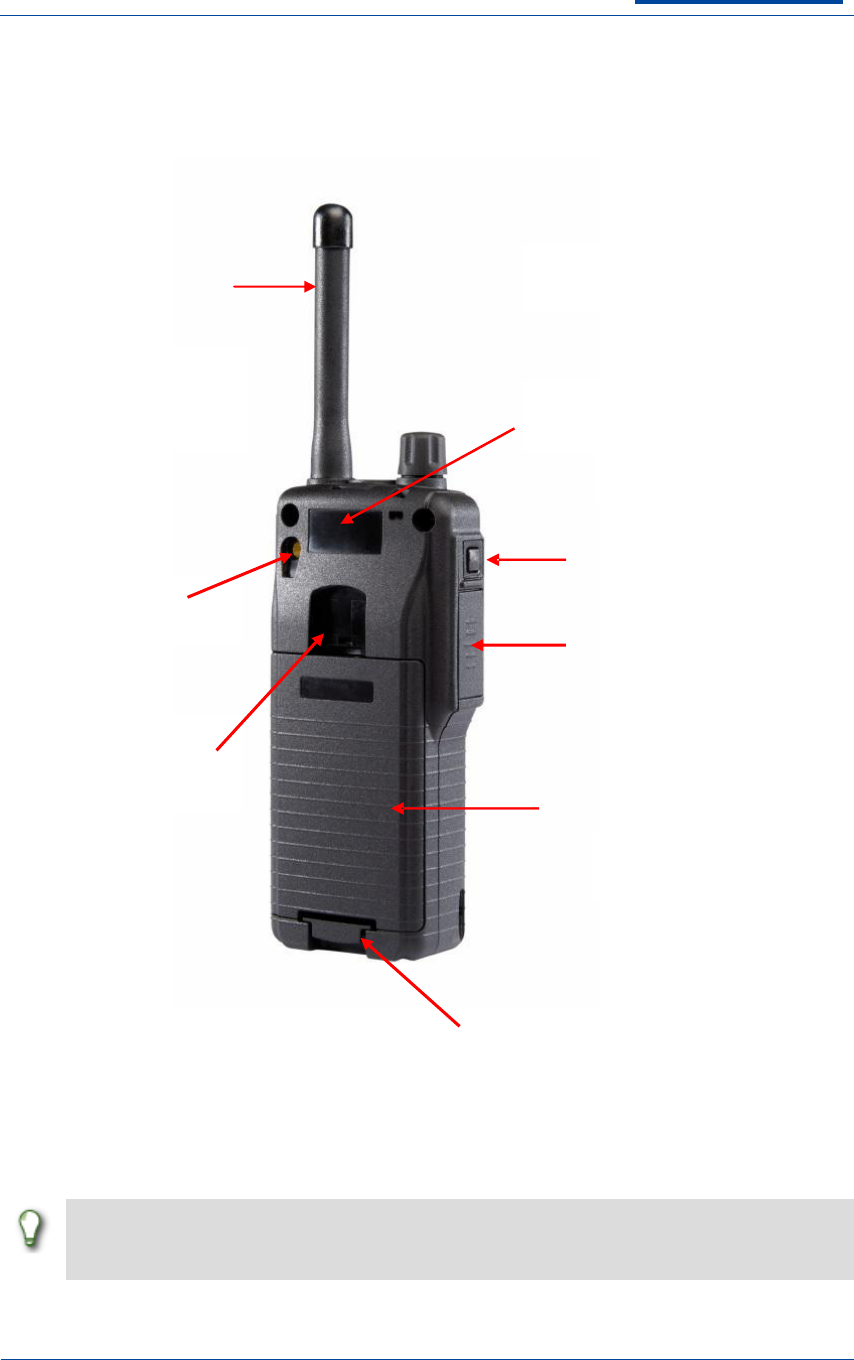
MOD-10-1164
sepura
TETRA Terminals
Product Guide
October 28th 2011
Page 13 of 36
Issue 5
© Sepura plc 2011
STP8000, STP8100, STP8200 REAR
To ensure optimal performance from your radio during half duplex calls (individual or
group) please hold the radio vertically, with the half duplex microphone situated
approximately 5cm away from the mouth.
Antenna
PTT
Programmable
Soft Key
Battery
Battery
release clip
Antenna
Connection
Carrying aid
attachment
point
Space for User
identity label
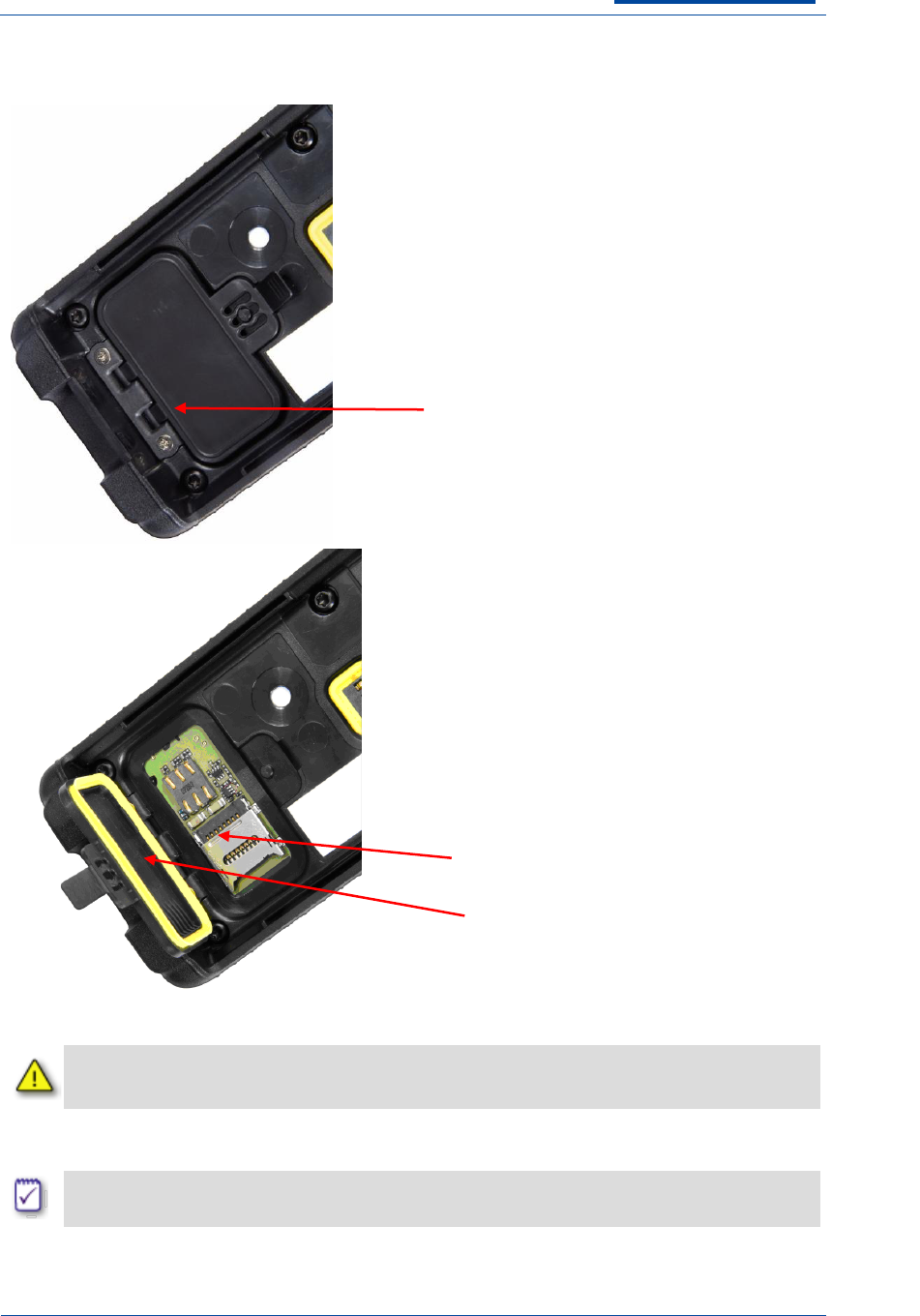
MOD-10-1164
sepura
TETRA Terminals
Product Guide
October 28th 2011
Page 14 of 36
Issue 5
© Sepura plc 2011
STP8000, STP8100, STP8200 REAR WITH BATTERY REMOVED
The SIM Card holder/Micro SD card cover should be left open in radios in storage and
latched closed under normal use.
The STP8200 does not support a Micro SD card. The connections and cover for the
card are not present on the radio
SIM Card holder/Micro SD card cover (closed)
SIM Card holder/Micro SD card cover (open)
Micro SD card (STP8000, STP8100)
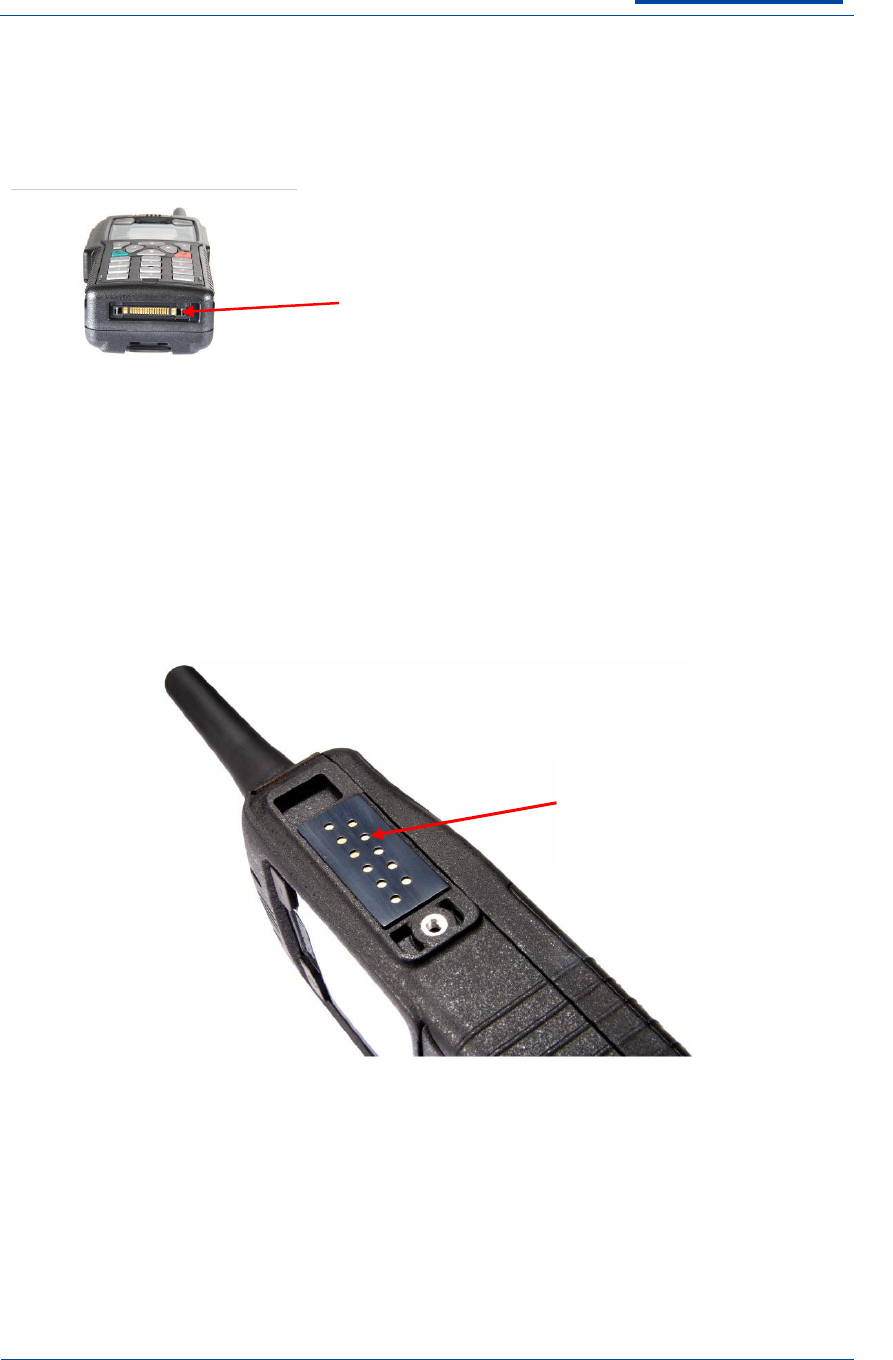
MOD-10-1164
sepura
TETRA Terminals
Product Guide
October 28th 2011
Page 15 of 36
Issue 5
© Sepura plc 2011
STP8000, STP8100, STP8200 FACILITY CONNECTOR
STP8000, STP8100, STP8200 RUGGED ACCESSORY CONNECTOR
STP8000, STP8100, STP8200 BATTERIES
Fitting and Removing the Battery
Before fitting a battery please ensure that the SIM Card holder/Micro SD card cover is latched
shut. To fit, unpack the battery and slot it into the rear of the radio. Push the battery down until
the catch clips into the bottom of the case. The battery is fully secure when this catch has
clipped into position. To remove, push the catch upward towards the top of the radio. The
battery pack unclips and can then be removed.
RSM,
Personal audio accessories,
Headsets
PEI
Car adapter
Charger connection
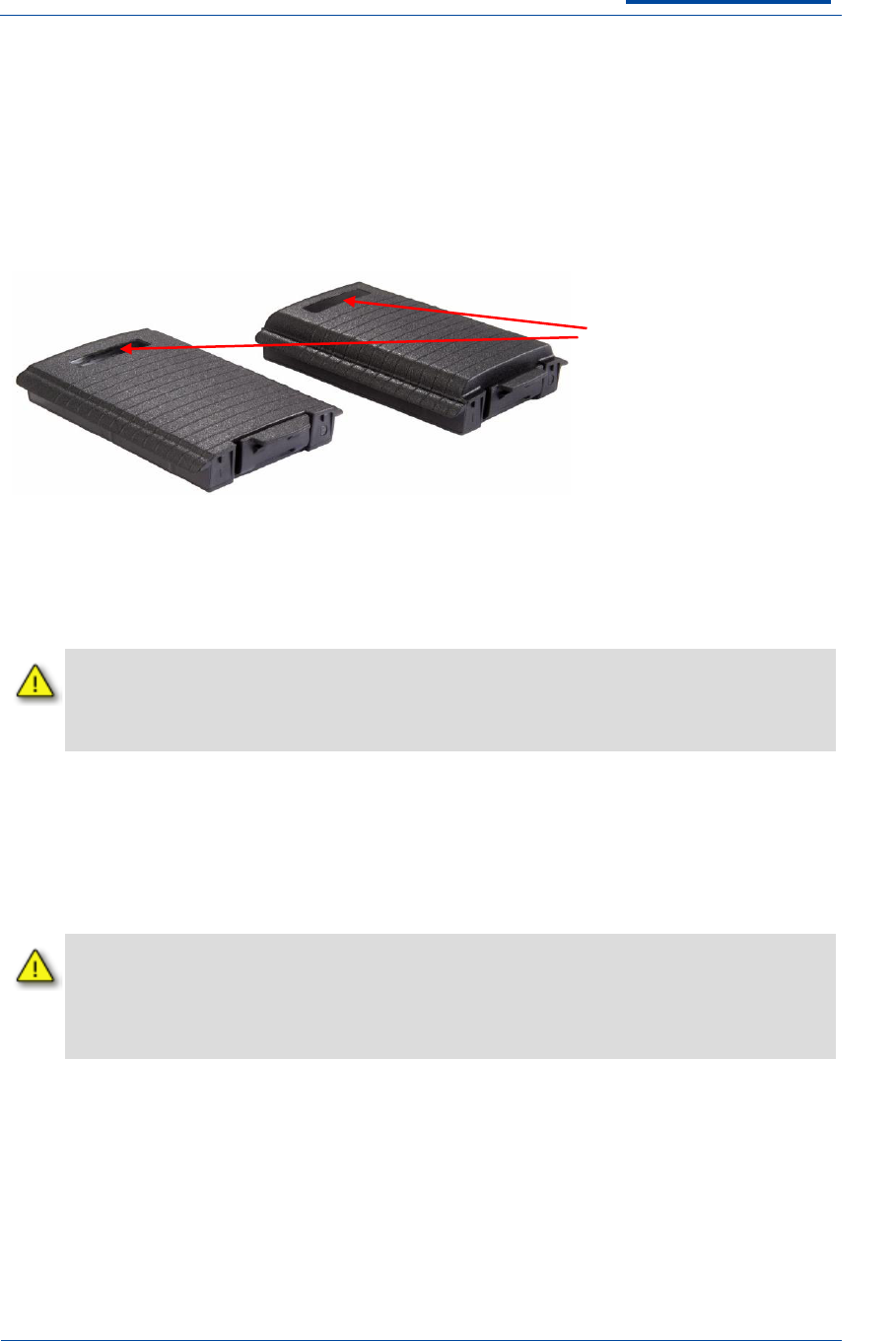
MOD-10-1164
sepura
TETRA Terminals
Product Guide
October 28th 2011
Page 16 of 36
Issue 5
© Sepura plc 2011
Battery Charging
New battery packs must be fully charged before they are used. The battery should only be
charged using Sepura plc approved battery chargers. Failure to use an approved battery
charger may invalidate the warranty of the battery and the radio.
A range of battery chargers is available that allow the battery to be charged while fitted to, or
removed from, the radio (depending upon the charger model selected). When the battery is
fitted to the radio, the battery can be charged via the facility connector located at the base of
the radio. If the battery is charged with the radio switched on, the time remaining to charge
the battery to its full capacity is shown on the radio‟s display.
When charging, the colour of the tri-colour LED on the radio indicates the progress of battery
charging: flashing amber shows waiting to charge, amber shows charging in progress, green
shows charging complete and red shows charging failure. A fully discharged battery may not
provide enough power to support the display during the initial phases of charging. However,
when sufficient power is available, the display will operate.
The mechanism for measuring the remaining charge in the battery may become
inaccurate over time. To avoid this, periodically run the battery flat in normal use (so
that the radio automatically switches off) and then re-charge the battery fully without
disconnecting it from the charger.
If a battery has been stored for a long time it may go flat and will not be able to power a radio
until it has been recharged. In extreme cases it may be necessary to restart the charging by
disconnecting and reconnecting the charger (or switching the charger off then on) as charging
will stop after twenty minutes if the battery has not recovered enough charge in that time to
power the radio.
The battery includes circuitry to protect against damage caused by accidental shorting
of the contacts. Once the battery has protected itself, it will not operate again reliably
until it has been removed from the radio and been fully re-charged. If the battery is not
fully re-charged the battery meter and time-to-charge indication on the radio may give
an inaccurate reading.
The amount of charge in a battery, shown as a percentage, is displayed on the Battery card in
the Radio Information menu. Please see section on Radio Information in the Sepura TETRA
Radios User Guide.
Space for user identity label

MOD-10-1164
sepura
TETRA Terminals
Product Guide
October 28th 2011
Page 17 of 36
Issue 5
© Sepura plc 2011
Low Battery Warning.
The radio warns the user when less than 12% of the charge
is left by displaying the Low Battery Icon on the top line of
the screen and repeatedly flashing the red LED for one
second at one second intervals. The Battery Level indicator
at the left hand side of the screen is also displayed in red on
the STP8000 and STP8100 radios.
When the battery is flat there is an audible alert just before
the radio switches off.
As with all batteries, charging cycles reduce the cell capacity. The battery is specified to have
retained a nominal 80% of its original fully charged capacity after 500 charge cycles. Charging
should be conducted using a Sepura approved charger.
Batteries have a finite life; they deteriorate if they are not charged on a periodic basis.
Batteries should not be left for more than 6 months without recharging as the cells will
deteriorate and the batteries will not be recoverable.
Many professional and consumer products from cycle lamps to mobile phones and laptop
computers now use rechargeable lithium polymer cells because of their small size and high
energy density. When charged and used correctly these are reliable and safe. There are
some simple precautions that should be observed when charging and using Lithium polymer
packs. The precautions below apply to most/all Lithium polymer battery packs and chargers.
1. Properly designed Lithium polymer batteries and chargers contain effective protection
circuitry to safeguard the pack during charging and use, but in some very rare
circumstances of internal cell failure during charging, the protection circuits may be
ineffective and the pack may overheat. To minimise the chance of this causing further
damage, Lithium polymer battery chargers should be used in well ventilated areas away
from combustible material. For example, charging of a TETRA battery, mobile phone
battery or laptop battery should not be carried out with the battery and charger very near
to curtains, soft furnishings, paper or other combustible material.
2. Copy batteries are available for many products including TETRA radios made by Sepura.
These may be cheaper than approved batteries, but may not include protection features
used in the approved battery, so may be less safe and should not be used.
When the radio is switched on the battery is tested to check that it is an authentic Sepura
battery. This information is displayed on the Battery card in the Radio Information menu.
Please see section on Radio Information. If a non-Sepura battery is detected a warning
message is displayed (“Unidentified battery - charging suspended”) which may be cleared
by any key press and if charging of the battery is attempted no charging will occur.
3. Use only Sepura approved chargers for charging Sepura products and Sepura approved
batteries.
Non-approved chargers may incorrectly charge the battery, leading to premature failure,
or render the battery potentially unsafe.
4. Sepura batteries are designed to be rugged and to give good service. However, as is the
case for all Lithium polymer batteries, it is possible for extreme mechanical damage to
weaken the internal structure of the cells within the battery. Therefore, if the battery
casing shows signs of severe damage (not the minor scratches and bumps of everyday
use), or has been subjected to major mechanical abuse, the battery should be safely
discarded immediately.
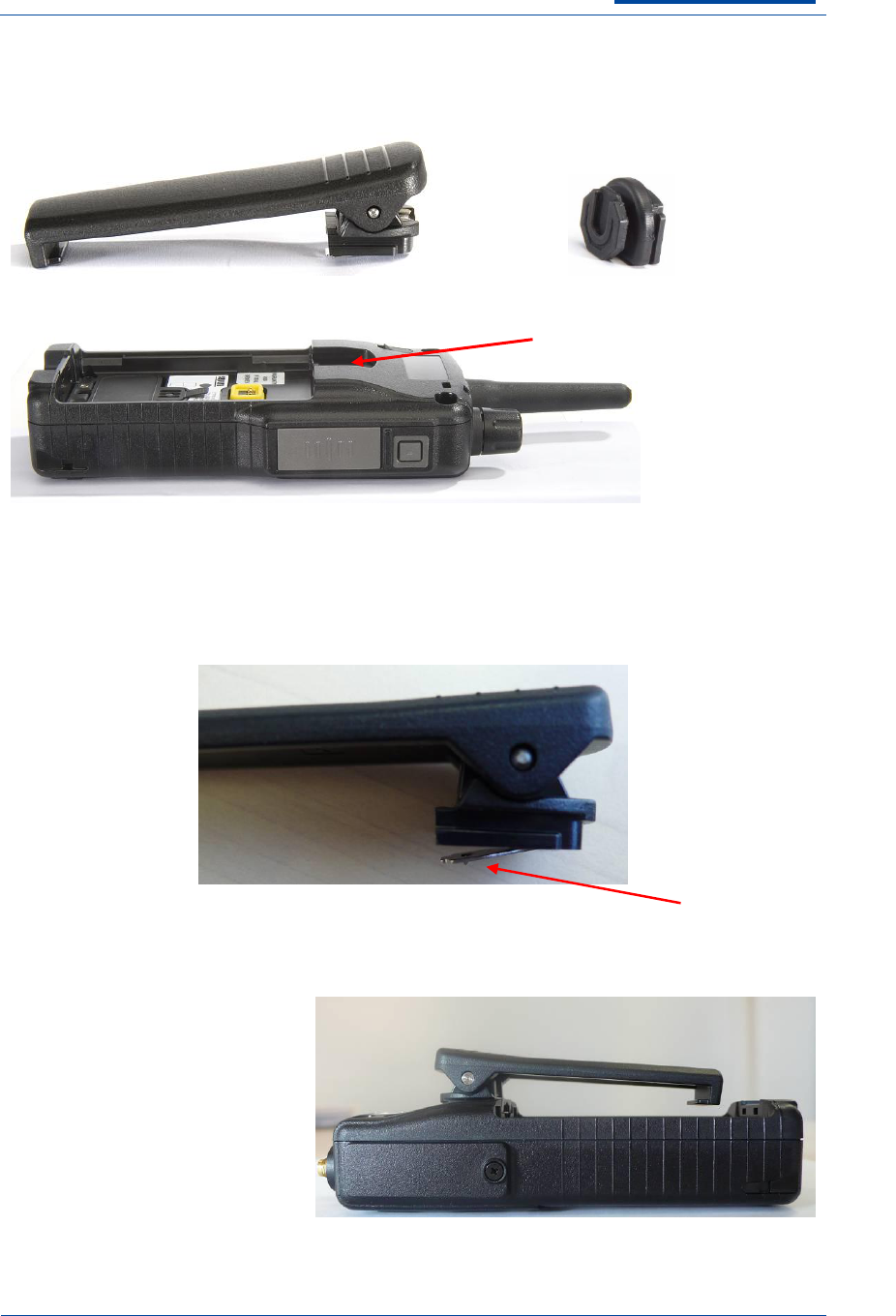
MOD-10-1164
sepura
TETRA Terminals
Product Guide
October 28th 2011
Page 18 of 36
Issue 5
© Sepura plc 2011
STP8000, STP8100, STP8200 BELT CLIP AND “KLICK FAST” STUD
The Belt Clip and “Klick Fast” Stud are both attached at the carrying aid attachment recess on
the rear of the radio. When attaching or removing the belt clip or stud please first remove the
battery.
The Belt Clip
Attaching The Belt Clip to the radio
To attach the belt clip to the
radio slide it into the carrying aid
attachment recess as shown.
Metal spring
BELT CLIP
“KLICK FAST” STUD
Carrying Aid Attachment Recess
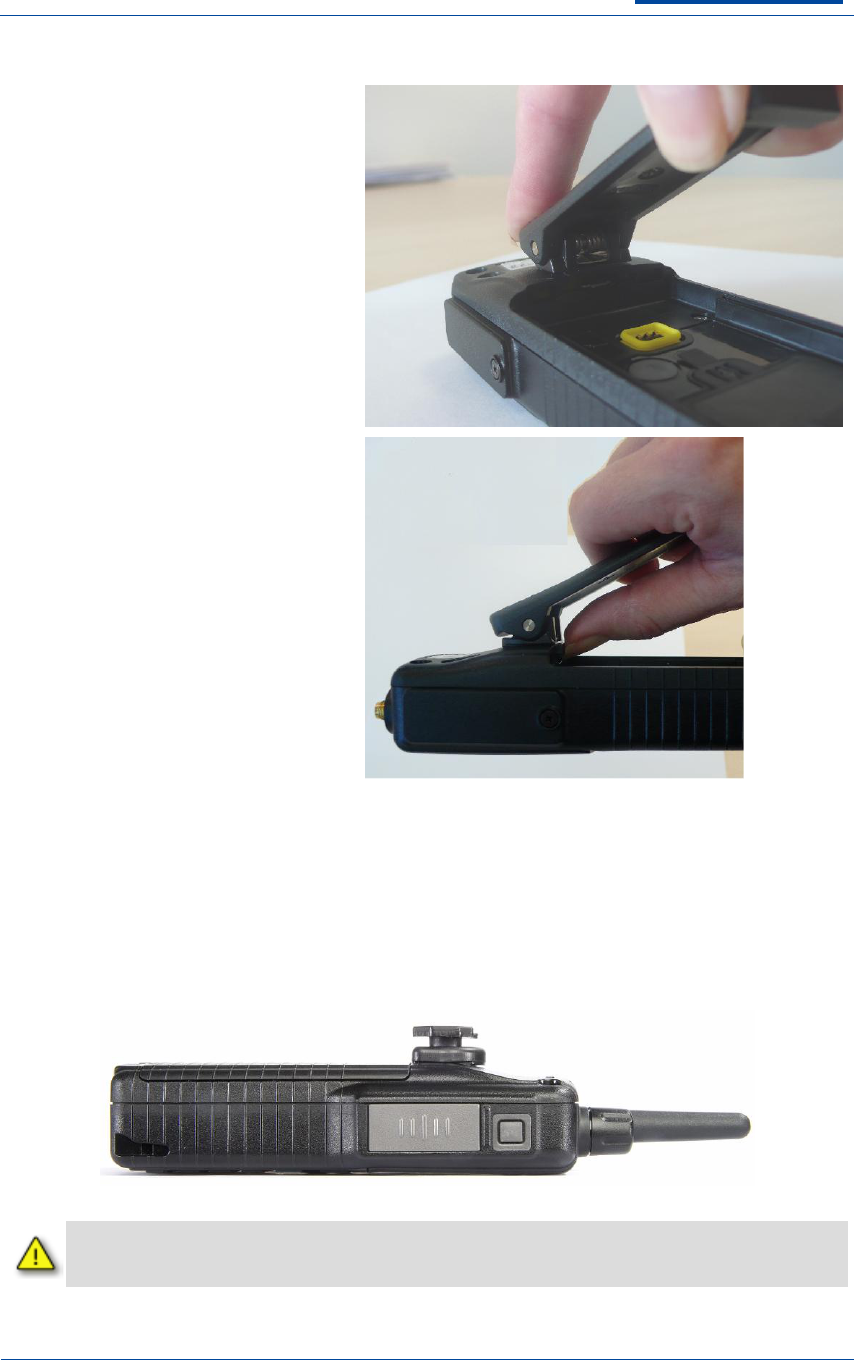
MOD-10-1164
sepura
TETRA Terminals
Product Guide
October 28th 2011
Page 19 of 36
Issue 5
© Sepura plc 2011
Detaching the Belt Clip from the Radio
To remove the belt clip from the radio
first carefully pull or lift the bottom
end of the belt clip away from the
radio.
Use your thumb or thumb nail to
compress the metal spring and
release the belt clip. It is then
possible to pull the belt clip so that it
slides out of the carrying aid
attachment recess.
The “Klick Fast” Stud
The “Klick Fast” Stud may be attached to the radio in the same way as the belt clip and
detached in a similar way by compressing the spring (which may be plastic) with the thumb or
thumb nail.
Attempting to remove the belt clip or stud without compressing the spring sufficiently
may result in damage to the accessory or to the radio.
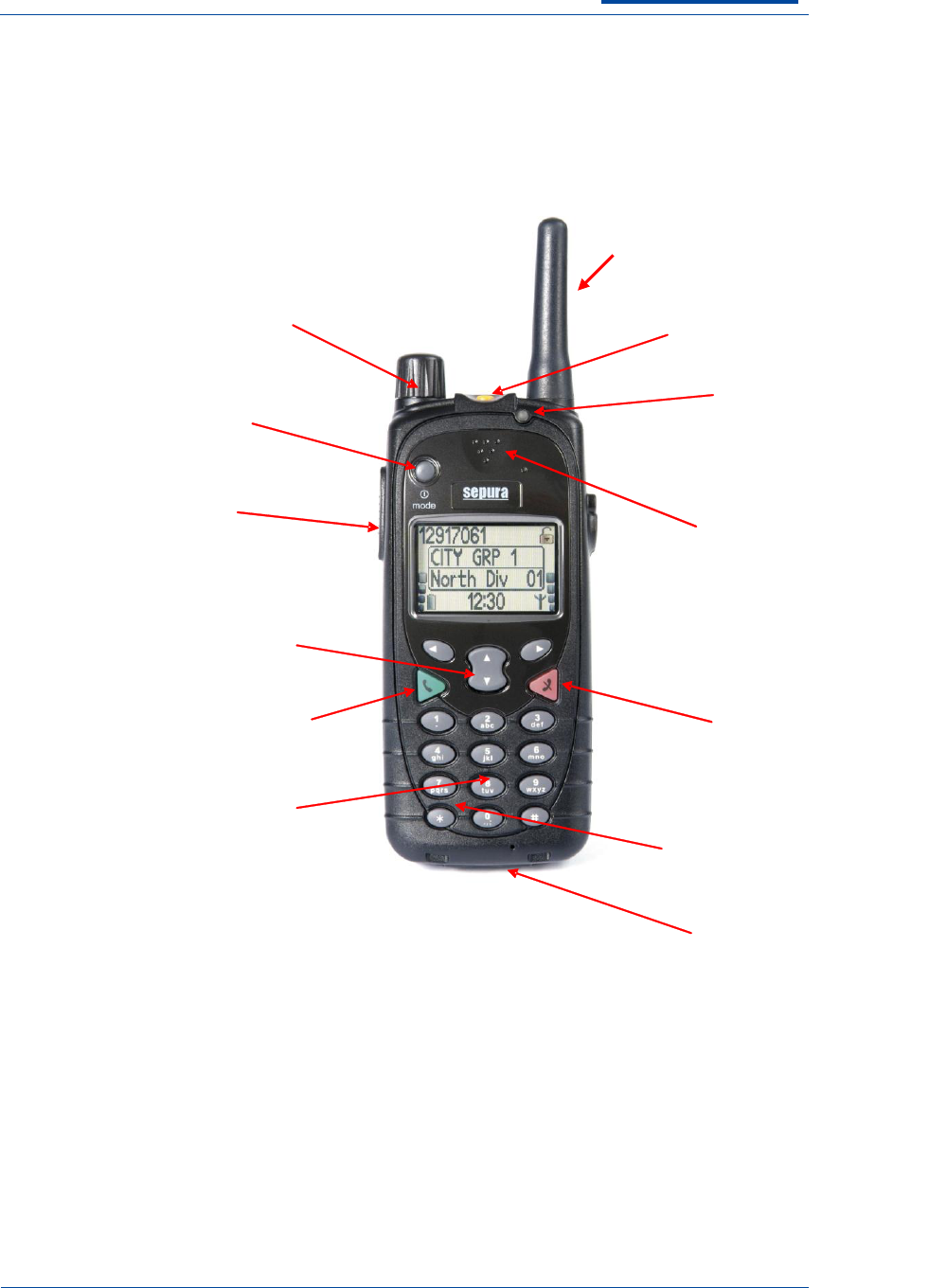
MOD-10-1164
sepura
TETRA Terminals
Product Guide
October 28th 2011
Page 20 of 36
Issue 5
© Sepura plc 2011
SRH3500, SRH3800, SRH3900
FRONT
Emergency Key
Navi-knob™
Mode Key
PTT
Navigation Keys
Duplex Earpiece and
Half
-
Duplex Microphone
Cancel/Home Key
Alphanumeric Keypad
Facility connector
Duplex Microphone
Tri
-
Colour LED
Select/Send Key
Antenna
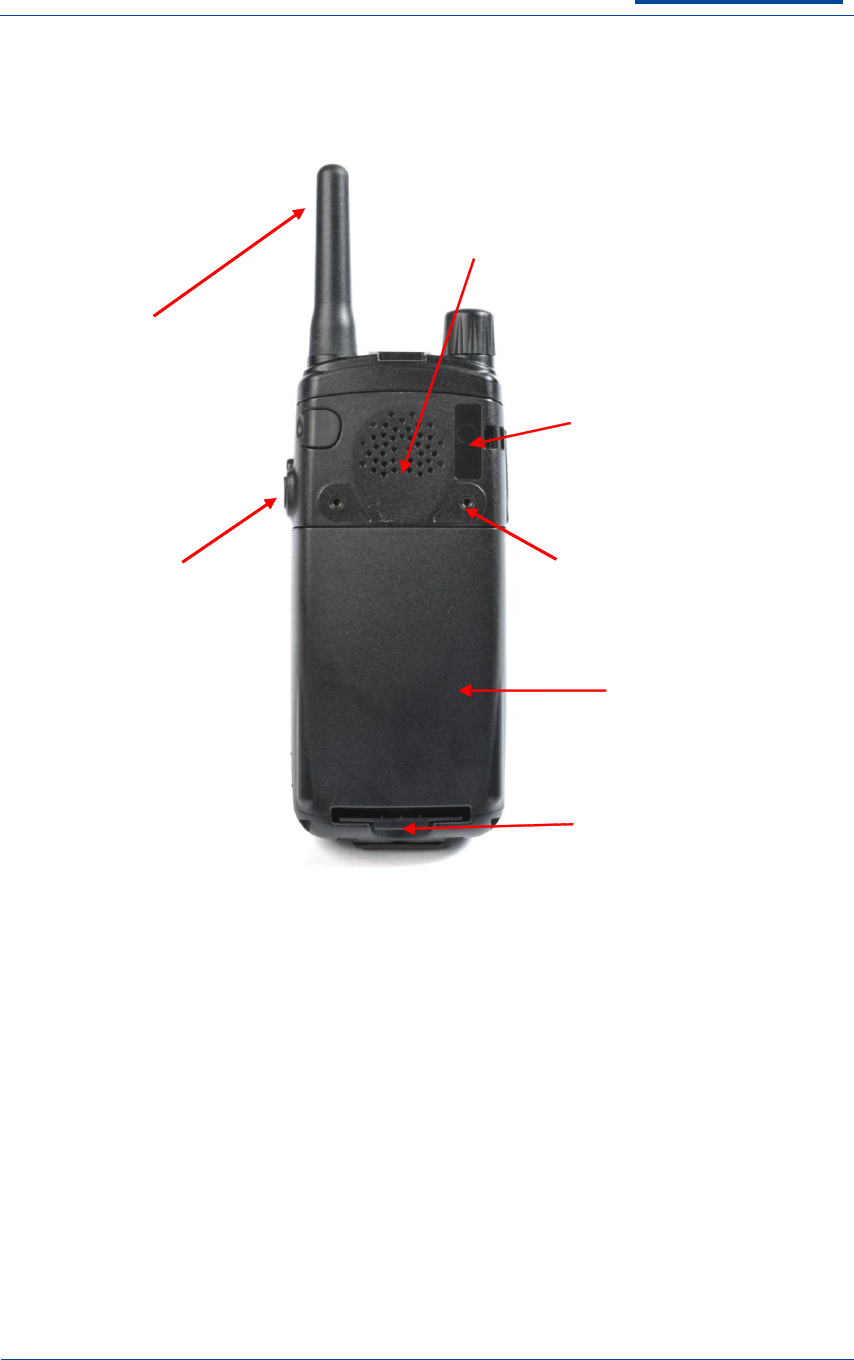
MOD-10-1164
sepura
TETRA Terminals
Product Guide
October 28th 2011
Page 21 of 36
Issue 5
© Sepura plc 2011
REAR
Half duplex
loudspeaker
Antenna
User identity
label recess
Carrying aids
mounting points
Battery
Battery
release clip
Audio
Accessories
Socket
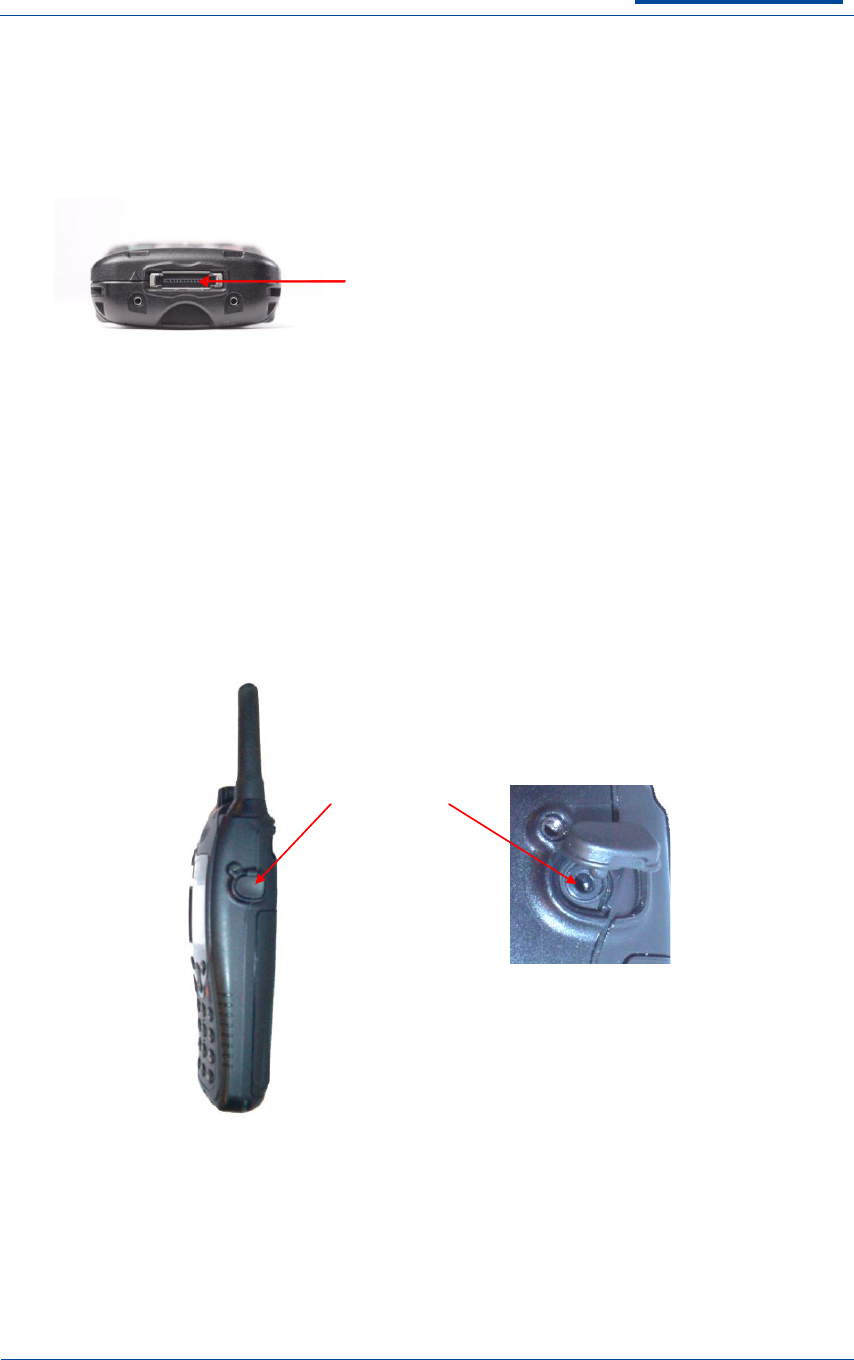
MOD-10-1164
sepura
TETRA Terminals
Product Guide
October 28th 2011
Page 22 of 36
Issue 5
© Sepura plc 2011
FACILITY CONNECTOR
ACCESSORIES SOCKET
Audio
Accessories
socket
BATTERIES
Fitting and Removing the Battery
To fit, unpack the battery and slot it into the rear of the hand-held. Push the battery down until
the catch clips into the bottom of the case. The battery is fully secure when this catch has
clipped into position. To remove, push the catch upward towards the top of the hand-held.
The battery pack unclips and can then be removed.
PEI,
Car adapter,
Charger connection,
RSM connector
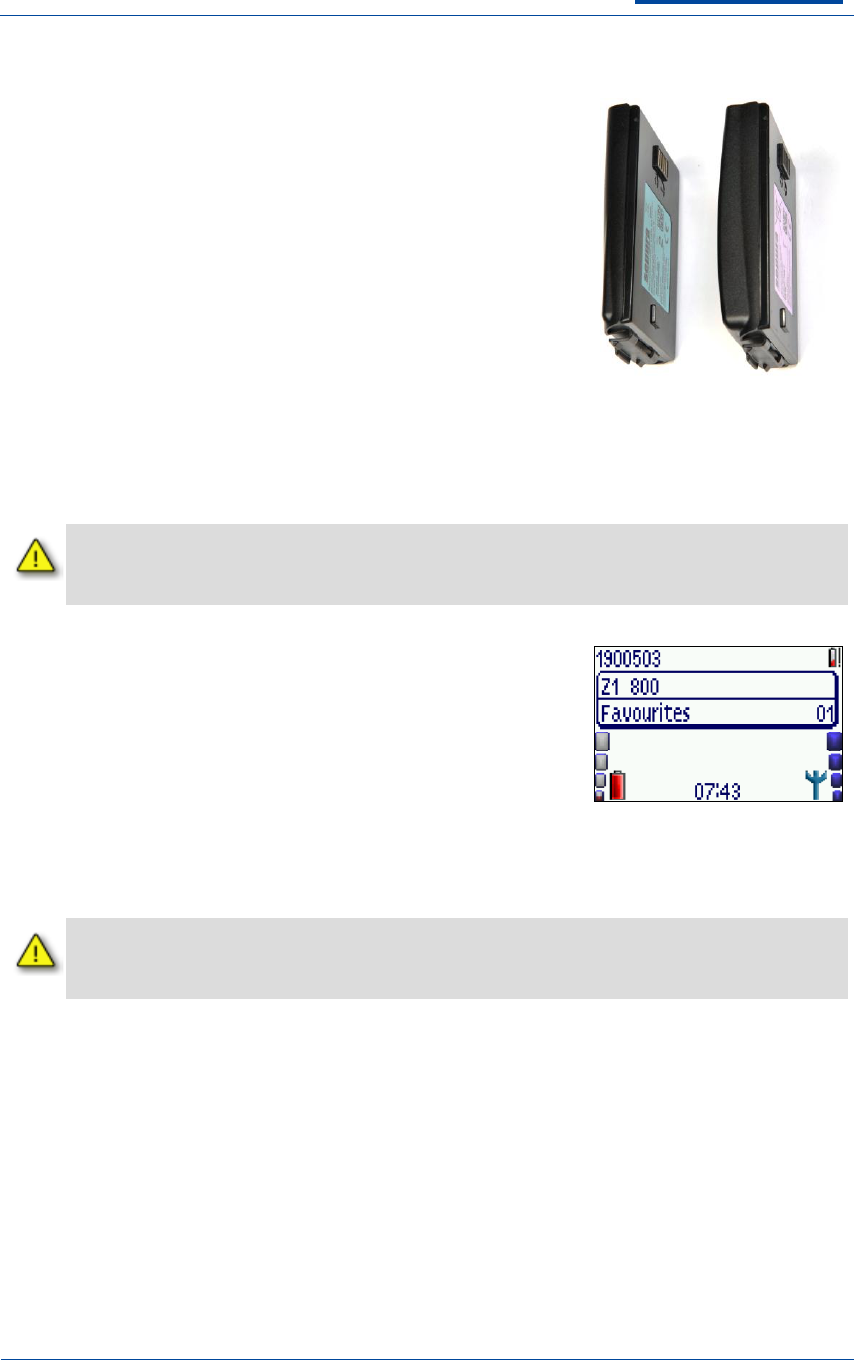
MOD-10-1164
sepura
TETRA Terminals
Product Guide
October 28th 2011
Page 23 of 36
Issue 5
© Sepura plc 2011
Battery Charging
The battery should only be charged with Sepura plc approved
battery chargers. Failure to use an approved battery charger
will invalidate the warranty of the battery and the hand-held.
A range of battery chargers is available that allow the battery
to be charged while fitted to, or removed from, the hand-held
(depending upon the charger model and hand-held type
selected). When the battery is fitted to the hand-held, the
battery can be charged via the facility connector located at the
base of the hand-held. If the battery is charged with the hand-
held switched on, the time remaining to charge the battery to
its full capacity is shown on the hand-held‟s display.
When charging, the colour of the LED on the hand-held
indicates the progress of battery charging: orange shows charging in progress, green shows
charging complete, red shows charging failure. A fully discharged battery may not provide
enough power to support the hand-held display during the initial phases of charging.
However, when sufficient power is available, the display will operate.
The battery includes circuitry to protect against damage caused by accidental shorting
of the contacts. Once the battery has protected itself, it will not operate again until it
has been removed from the hand-held and charged.
The hand-held warns the User of a Low battery condition by
displaying the Low battery Icon and repetitively flashing the
Red LED for 1 second at 1 second intervals. The Battery Level
indicator at the left hand side of the screen is also displayed in
red on the SRH3800 and SRH3900 radios.
As with all batteries, charging cycles reduce the cell capacity. The battery is specified to have
retained a nominal 80% of its original fully charged capacity after 500 charge cycles. Charging
must be conducted using a Sepura approved charger.
Batteries have a finite life; they deteriorate if they are not charged on a periodic basis.
Batteries should not be left for more than 6 months without recharging as the cells will
deteriorate and the batteries will not be recoverable.
Many professional and consumer products from cycle lamps to mobile phones and laptop
computers now use rechargeable lithium-ion (Li-ion) cells because of their small size and high
energy density. When charged and used correctly these are reliable and safe. There are
some simple precautions that should be observed when charging and using Li-ion packs. The
precautions below apply to most/all Li-ion battery packs and chargers.
1. Properly designed Li-ion batteries and chargers contain effective protection circuitry to
safeguard the pack during charging and use, but in some very rare circumstances of
internal cell failure during charging, the protection circuits may be ineffective and the pack
may overheat. To minimise the chance of this causing further damage, Li-ion battery
chargers should be used in well ventilated areas away from combustible material. For
example, don‟t charge your TETRA battery, mobile phone battery or laptop battery with
the battery and charger very near to curtains, soft furnishings, paper or other combustible
material.

MOD-10-1164
sepura
TETRA Terminals
Product Guide
October 28th 2011
Page 24 of 36
Issue 5
© Sepura plc 2011
2. Copy batteries are available for many products, particularly mobile phones and more
recently TETRA radios, including those made by Sepura. These may be cheaper than
approved batteries, but may not include protection features used in the approved battery,
so may be less safe and should not be used.
3. Use only Sepura approved chargers for charging Sepura products. Non-approved
chargers may incorrectly charge the battery, leading to premature failure, or render the
battery potentially unsafe.
4. Sepura batteries are designed to be rugged and to give good service. However, as is the
case for all Li-ion batteries, it is possible for extreme mechanical damage to weaken the
internal structure of the cells within the battery. Therefore, if the battery casing shows
signs of severe damage (not the minor scratches and bumps of everyday use), or has
been subjected to major mechanical abuse, do not continue to use the battery.

MOD-10-1164
sepura
TETRA Terminals
Product Guide
October 28th 2011
Page 25 of 36
Issue 5
© Sepura plc 2011
MOBILE / GATEWAY RADIO RANGE
SRG3000 Series Transceivers
Applications Interface Unit
SRG3000 Series Consoles
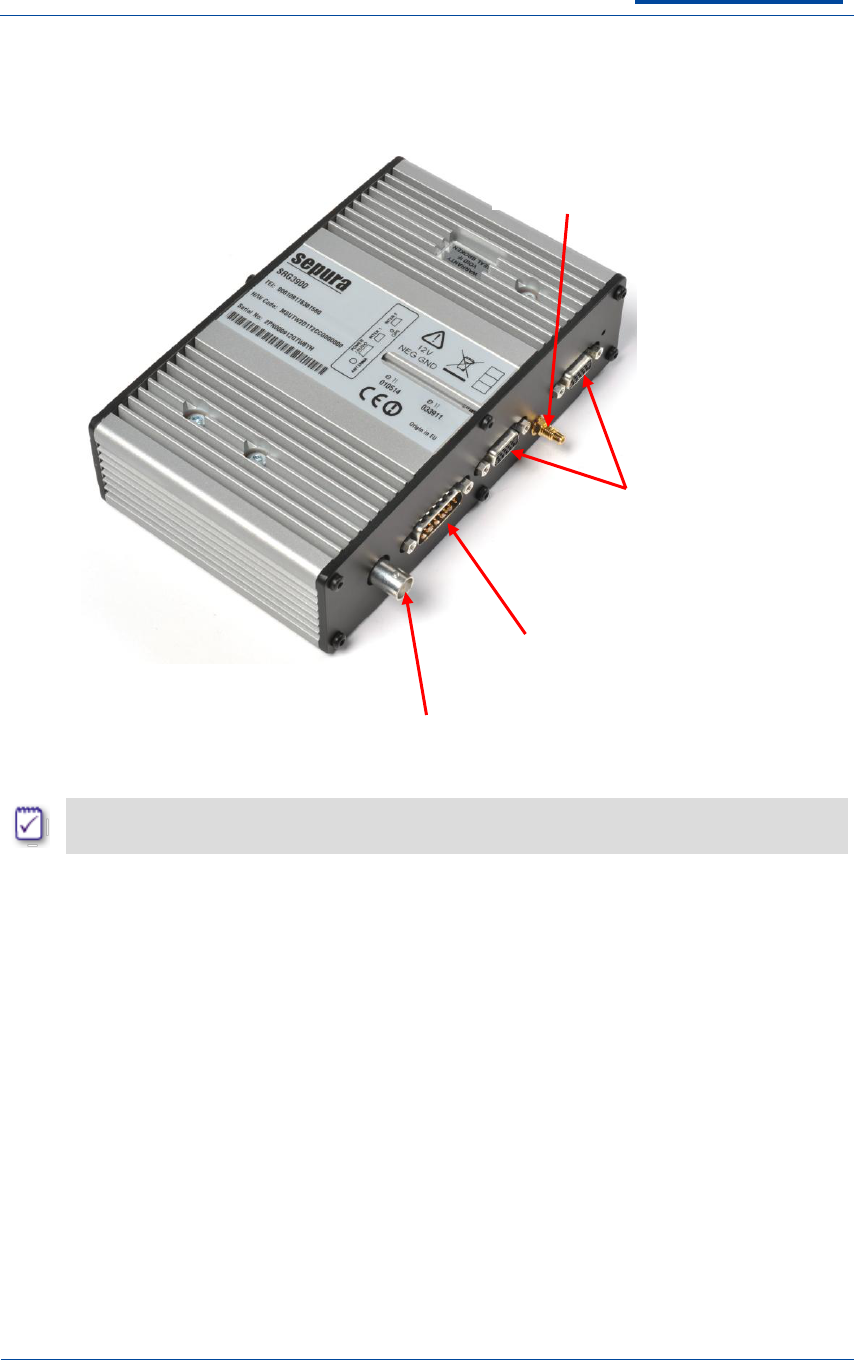
MOD-10-1164
sepura
TETRA Terminals
Product Guide
October 28th 2011
Page 26 of 36
Issue 5
© Sepura plc 2011
SRG3000 MOBILE / GATEWAY TRANSCEIVER
The finish on the SRG3000 transceivers may vary.
In order to operate the following components are required:
TETRA Mobile / Gateway Transceiver Unit
Power Cable Assembly
An Antenna
Optional accessories that may be included:
Colour Console, Standard Console or Handset Based Console Unit
Applications Interface Unit
The Mobile or Gateway Radio should be installed by following the instructions in the
Installation Guide.
Antenna Connector
Power, audio and
external control lines
Console Ports or
Dual PEI Ports
GPS Antenna
Connector
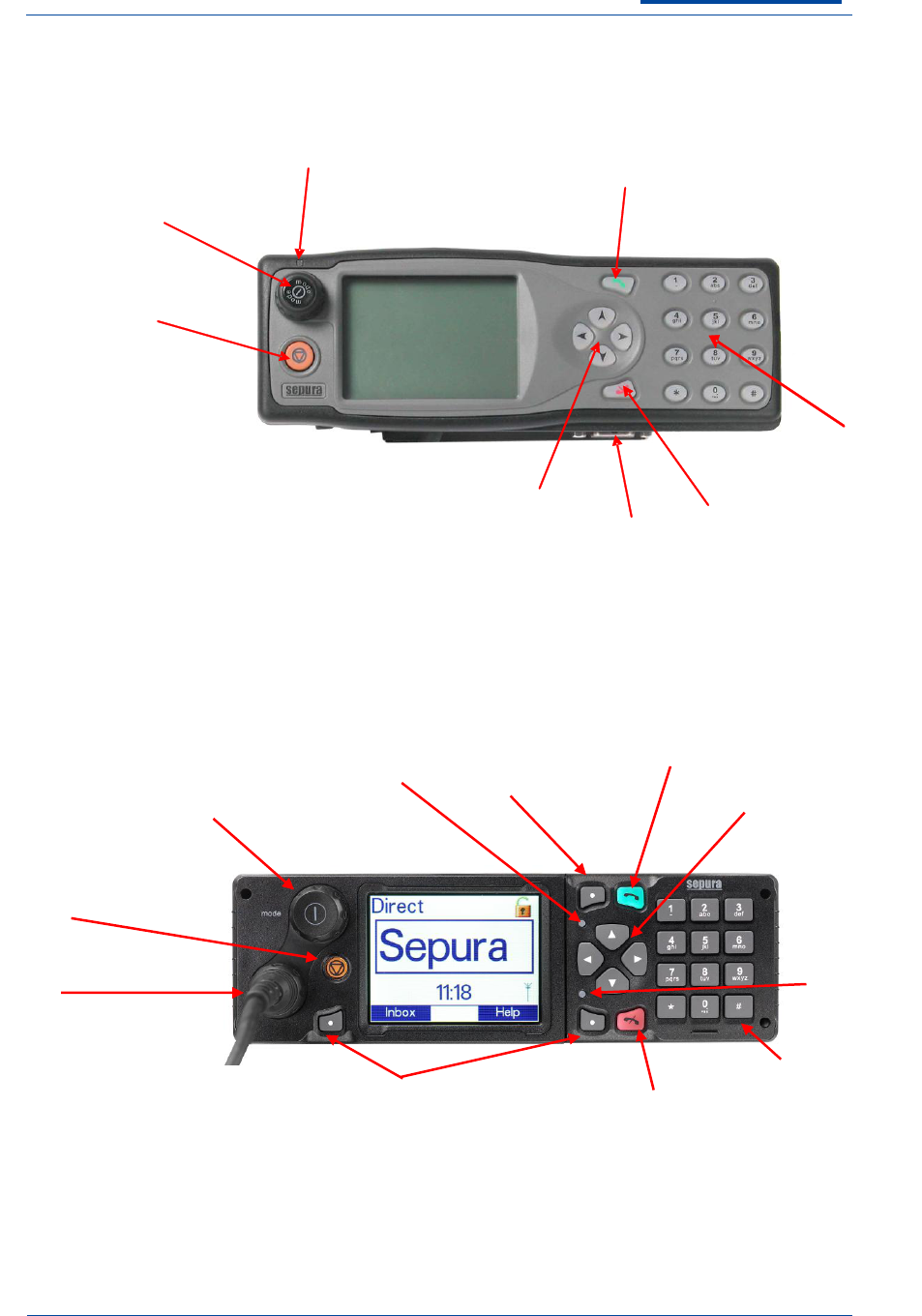
MOD-10-1164
sepura
TETRA Terminals
Product Guide
October 28th 2011
Page 27 of 36
Issue 5
© Sepura plc 2011
STANDARD CONSOLE
COLOUR CONSOLE
Navi-knob™ (rotate)
Mode Key (press)
Navigation Keys
Cancel/Home Key
Select/Send Key
Tri
-
Colour LED
PEI Port
Emergency
Key
Alphanumeric
Keypad
Alphanumeric
Keypad
Cancel/Home Key
Navigation Keys
Emergency
Key
Navi-knob™ (rotate)
Mode Key (press)
Select/Send Key
TRI-Colour
LED
Context Keys
VAC
Soft Key
(Default is Missed
Event Key)
Blue LED
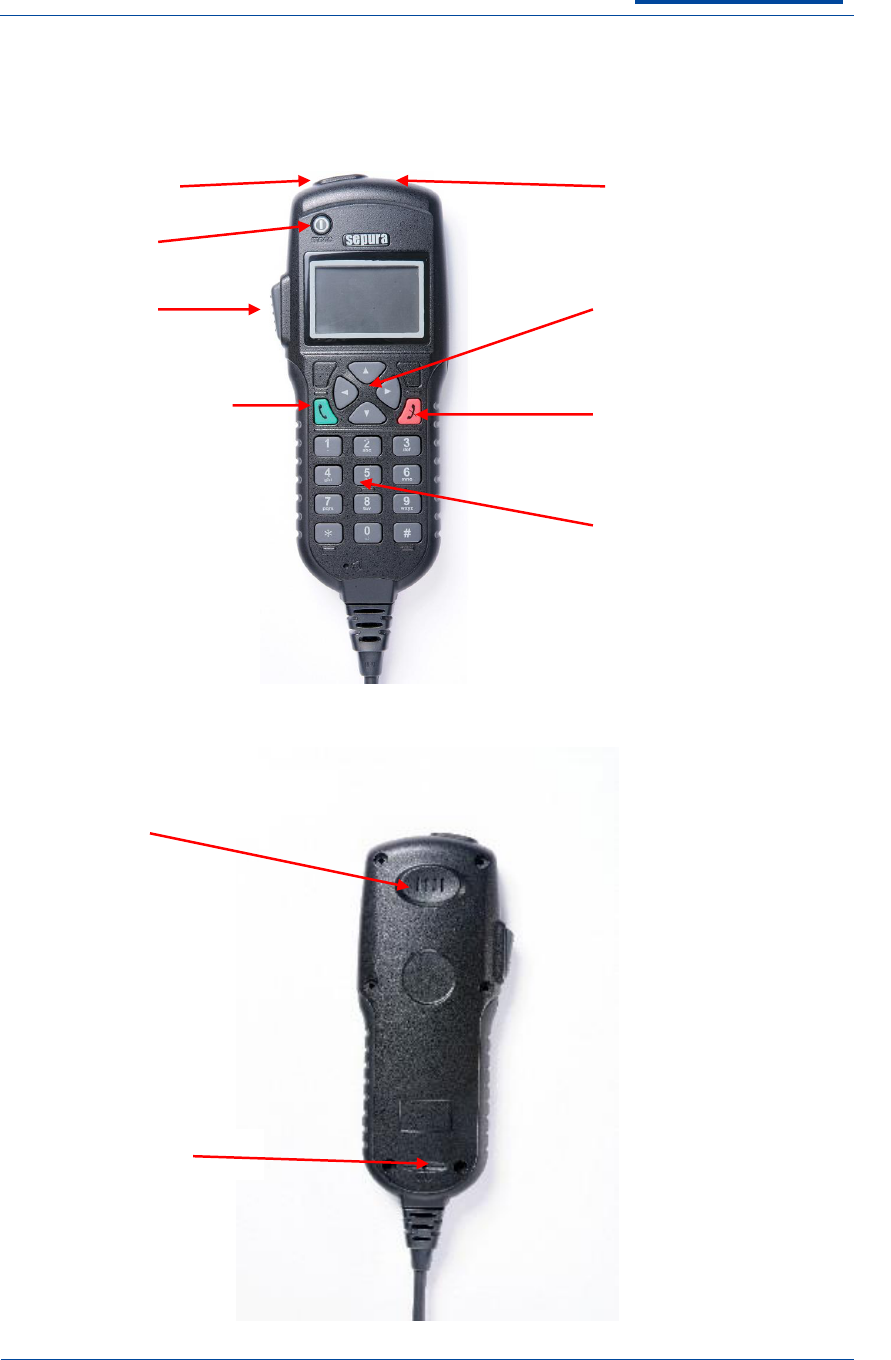
MOD-10-1164
sepura
TETRA Terminals
Product Guide
October 28th 2011
Page 28 of 36
Issue 5
© Sepura plc 2011
HANDSET BASED CONSOLE
Front
Rear
Navi-Keys
PTT
Emergency Key
Cancel/Home Key
Alphanumeric Keypad
Select/Send Key
Navigation Keys
Mode Key
Earpiece
Microphone

MOD-10-1164
sepura
TETRA Terminals
Product Guide
October 28th 2011
Page 29 of 36
Issue 5
© Sepura plc 2011
APPLICATIONS INTERFACE UNIT
MOBILE / GATEWAY RADIO ACCESSORIES
CONSOLE AND APPLICATIONS INTERFACE UNIT
The Mobile/Gateway radio supports the connection of up to two console units. Each console
unit can be a Standard Console, Colour Console or a Handset Based Console, complete with
keypad and display, or an Applications Interface Unit, which is similar to a console but which
does not have a keypad and display. This enables the mobile to support the connection of up
to 6 audio accessories.
If two consoles are fitted, they both display the same information. This makes it possible for a
user to move from one console to another without having to take any special action. If two
users are using the same Mobile/Gateway radio, operational procedures are required to
ensure that the actions of the two users do not conflict.
On some configurations it is possible to have a hands-free kit attached to each console. If this
is the case, only one of the remote microphones is live during a call. The remote microphone
which is live is the one attached to the console which accepted or made the call or switched
the call to hands-free.
AUDIO ACCESSORIES
The Mobile/Gateway radio supports up to 6 audio accessories, which can be any combination
selected from:
Standard Console, Colour Console, Applications Interface Unit:
o none to two hands-free kits
o none to four standard handsets
o none to four standard fist microphones
In addition to the above, the Colour Console also supports:
Programming Lead
Connection
PTT Jack Socket
Microphone Jack Socket
Accessory Connection
(not used if Jack
Sockets are in use)
Accessory Connection
Connection to Transceiver

MOD-10-1164
sepura
TETRA Terminals
Product Guide
October 28th 2011
Page 30 of 36
Issue 5
© Sepura plc 2011
o none to two VAC handsets
o none to two VAC speaker microphones (which may be configured as fist
microphones)
Handset Based Console:
o built-in handset
o none to one hands-free kit
MOBILE / GATEWAY RADIO AUDIO CONTROL
The Mobile/Gateway radio supports the concept of a single controlling audio accessory for a
call. The controlling audio accessory is the one in control of the call, and the only one on
which the microphone becomes active.
When a fist microphone or hands-free kit is used, the received audio is directed to the
loudspeaker connected to the mobile unit. When a handset is used, the received audio
is directed to the handset earpiece.
The controlling audio accessory is normally the Remote Microphone used in conjunction with
the Loudspeaker, i.e. the hands-free kit or „Public‟ mode. If the user requires that a different
accessory should become the controlling accessory this may be achieved by pressing the
PTT key on that accessory or by taking that accessory off hook. If the new controlling
accessory has an earpiece then normally this is used for received audio instead of the
Loudspeaker („Private‟ mode).
When in „Private‟ mode the user can switch to „Public‟ mode by pressing the hands free soft
key if configured. Taking a handset off hook, or using its PTT will return to „Private‟ mode.
While the controlling accessory is not the Remote Microphone, the user may switch to
another accessory by pressing the PTT key on that accessory. Taking that accessory off-hook
does not change the controlling accessory. This allows a second user to listen to received
audio on another accessory.
If the controlling accessory is placed on-hook this clears the call unless customised
differently. Other accessories can be put back on-hook without clearing the call in progress.
All earpiece audio is left on all the time in order that multiple users may listen to the received
audio.
The audio presentation for duplex calls depends on the capability of the controlling accessory.
With a duplex controlling accessory, duplex calls have a duplex presentation. With a half
duplex accessory, duplex calls are controlled using the PTT key.

MOD-10-1164
sepura
TETRA Terminals
Product Guide
October 28th 2011
Page 31 of 36
Issue 5
© Sepura plc 2011
RADIO OPERATION
See the Sepura TETRA Radios User Guide for information regarding the user operation of the
radios.

MOD-10-1164
sepura
TETRA Terminals
Product Guide
October 28th 2011
Page 32 of 36
Issue 5
© Sepura plc 2011
HEALTH AND SAFETY
USER INFORMATION
CARE OF YOUR RADIO
Use only a slightly damp soft cloth for cleaning all exterior surfaces. Do NOT use chemical
aerosol or abrasive cleaners.
To ensure efficient operation, clean the battery contacts periodically with a soft, dry cloth.
Never leave the radio in extreme temperatures (over 55°C), for example behind glass in very
hot, direct sunlight.
BATTERIES
Safety
Please observe the following before handling batteries:
To prevent injury, do not allow metal objects to contact or short circuit the battery radios.
Make sure that the battery radios do not become dirty.
Do not immerse in water or incinerate.
If you need to replace the battery, use the Sepura plc approved battery types.
Disposal
Batteries must be disposed of in the correct manner according to Sepura environmental
policy. If in any doubt, refer to your supplier or local Sepura plc representative.
ACCESSORIES
Only accessories supplied or approved by Sepura plc are recommended for use with the
radios. Any accessory used that is not supplied or approved by Sepura plc could cause
damage to the radios and may invalidate the warranty. For safety reasons Sepura plc do not
recommend that accessories be used with a radio without first gaining approval from Sepura
plc to do so.
TRANSMIT INHIBIT
The radio can be switched into Transmit Inhibit should the user enter a RF sensitive area (e.g.
a hospital). This mode is indicated by the tri-colour LED rapidly flashing amber 4 times at
approximately two second intervals and the display of the transmit inhibit icon in the top right
hand corner of the screen.
In this state, the radio does not transmit under any circumstances in either TMO or DMO,
except when using the emergency key if customised to do so. The radio remains on the
selected group and in some circumstances can still receive conversations from this talkgroup.
The radio can automatically send a status message to the customised destination when the
radio enters Transmit Inhibit, and again when it leaves Transmit Inhibit.

MOD-10-1164
sepura
TETRA Terminals
Product Guide
October 28th 2011
Page 33 of 36
Issue 5
© Sepura plc 2011
Use of the emergency key whilst in Transmit Inhibit is supported; however, the time to set up
the emergency call could be increased by a few seconds.
ANTENNA
When fitting the antenna, do not over-tighten. Do not use the radio without the antenna
attached unless the radio is being used with an external antenna (e.g. on RSM).
ACOUSTIC SHOCK
Sepura plc has engineered an innovative audio solution for the radio. Duplex audio (for
telephone type calls) and the half duplex audio (for radio calls) are directed to different
loudspeakers.
Duplex audio is routed to the low power Duplex Earpiece on the front of the radio. A more
powerful loudspeaker, situated behind the alpha-numeric keypad on the STP8000 radios,
behind the panel on the lower front of the STP8100 and STP8200 radios and on the rear of
the SRH3000 series radios, is used for half duplex audio. This loudspeaker directs the loud
audio away from a user‟s ear should the user accidentally answer a half duplex call as though
it were a duplex call.
WARNING: Hold the radio close to the ear only when making, or receiving, duplex calls.
WATER INGRESS
This section applies to the STP8000, STP8100 and STP8200 radios only
If the radio is used in extremely heavy rain it is possible that some water may seep
behind the keys on the keypad. This will not harm the radio but may reduce the
volume of the loudspeaker. If this occurs it may be easily remedied by holding the
radio firmly and shaking it once or twice to remove the water.

MOD-10-1164
sepura
TETRA Terminals
Product Guide
October 28th 2011
Page 34 of 36
Issue 5
© Sepura plc 2011
GLOSSARY
Term
Description
Gateway
A device which allows users working in Direct Mode to communicate
with users in Trunked Mode. (This is often used to extend the working
range of a radio)
Duplex
Duplex calls are telephone type calls in which both parties can talk
simultaneously.
ETSI
European Telecommunications Standards Institute
Half duplex
Half duplex calls are when only one party can talk (transmit) at any
time.
LED
Light Emitting Diode
Navi-knob™
A continuous rotating knob on the top of the radio that is used for
talkgroup and status message selection, as well as controlling the
volume.
NRPB
National Radiological Protection Board
PEI
Peripheral Equipment Interface
PTT
Press To Talk
RSM
Remote Speaker Microphone
TETRA
Terrestrial Trunked Radio

MOD-10-1164
sepura
TETRA Terminals
Product Guide
October 28th 2011
Page 35 of 36
Issue 5
© Sepura plc 2011
ACKNOWLEDGEMENTS
1) The Sepura STP8000 and STP8100 series radios contain iType™ from Monotype Imaging
Inc.
2) The Bluetooth® word mark and logos are owned by the Bluetooth SIG, Inc. and any use of
such marks by Sepura plc is under licence. Other trademarks and trade names are those of
their respective owners.
Bluetooth® Qualified Device ID : B013965
3) The Independent JPEG Group
The Radio software is based in part on the work of the Independent JPEG Group.
4) The SDA Group
Micro SD cards.

MOD-10-1164
sepura
TETRA Terminals
Product Guide
October 28th 2011
Page 36 of 36
Issue 5
© Sepura plc 2011
NOTICE
All rights reserved. This document may not be reproduced in any form either in part or in
whole without the prior written consent of Sepura plc, nor may it be edited, duplicated or
distributed using electronic systems.
Company and product names mentioned in this document may be protected under copyright
or patent laws.
The information in this document is subject to change without notice and describes only the
products defined in this document. This document is intended for the use of Sepura plc‟s
customers and/or other parties only for the purposes of the agreement or arrangement under
which this document is submitted, and no part of it may be reproduced or transmitted in any
form or means without the prior written permission of Sepura plc.
CONTACT DETAILS
Sepura plc
Radio House
St Andrew‟s Road
Cambridge CB4 1GR
United Kingdom
Web :
www.sepura.com
Tel:
+44 (0)1223 876000
Fax:
+44 (0)1223 879000